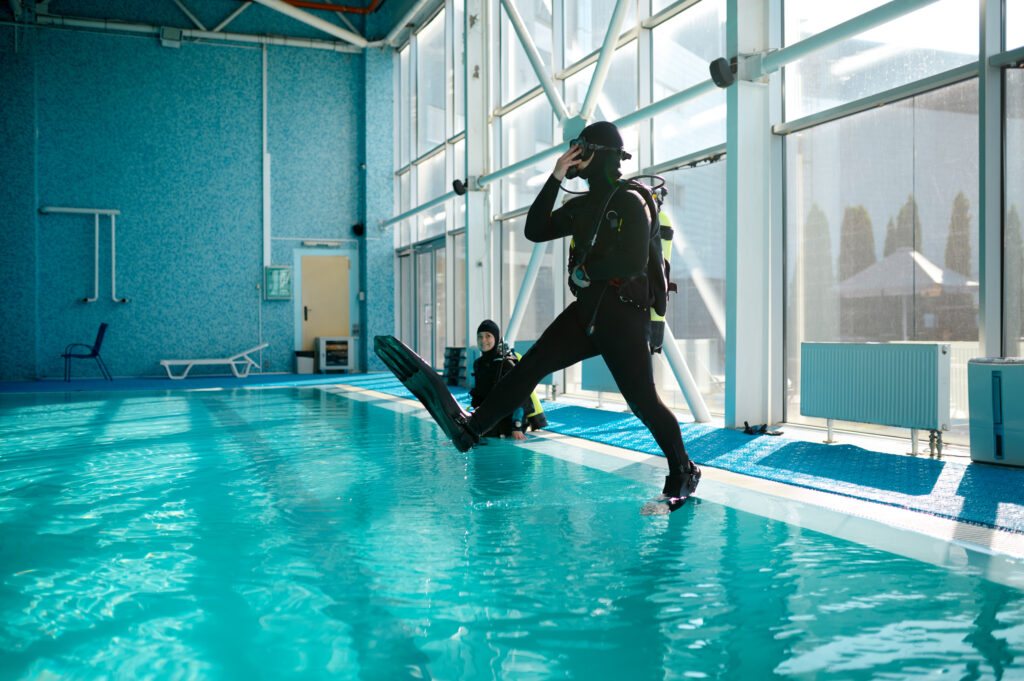What is Deep Diving?

Deep diving is a specialized category of scuba diving that involves descending beyond 18 meters (60 feet) underwater.
What is a Safety Stop during Scuba Diving?

A safety stop is a voluntary pause during a diver’s ascent, usually lasting around 3 minutes and occurring at a depth of approximately 5 meters (15 feet).
What is Cavern Diving?

Cavern diving is a distinct form of scuba diving that involves exploring natural underwater caverns, allowing divers to experience the beauty and mystery of submerged cave systems. Unlike cave diving, where divers venture deep into the labyrinthine recesses of underwater cave networks, cavern diving stays within the sunlit zone, offering a safer and more controlled environment. Cavern divers do not stray far from the surface, ensuring they remain within a short distance of an emergency exit point. This sport attracts those fascinated by unique underwater formations, offering an adventurous alternative to traditional open-water diving.
What is it to “Call a Dive” When Scuba Diving?

In scuba diving, the term “call a dive” refers to the decision to end a dive and return to the surface. This decision is a critical aspect of dive safety and can be made by the diver, their buddy, or the dive leader. The rationale for calling a dive can vary from diver safety concerns to environmental changes, but it always centers on ensuring the well-being of all involved. By understanding when and why to call a dive, divers can prevent potentially dangerous situations and avoid unnecessary risks.
What is a Lost Buddy Drill?

The lost buddy drill is a critical safety procedure in scuba diving designed to locate a missing dive partner and ensure the safety of both divers. When a buddy pair becomes separated underwater, it is vital to act quickly and effectively to minimize risk. This drill outlines a series of steps to be taken in such an event, focusing on maintaining calm, executing a systematic search, and communicating effectively. The lost buddy drill is an essential part of scuba training and is emphasized for all levels of divers, from beginners to advanced technical divers, due to its potential to prevent accidents and save lives.
What is Night Diving?

Night diving is a thrilling and unique scuba diving experience that occurs after the sun has set, opening up a world of underwater wonders unseen during the day. It offers divers an opportunity to witness the nocturnal behaviors of marine life and the vibrant colors that are often lost in the daylight. The contrast between the darkness of the water and the focused beam of a dive light creates an atmosphere of mystery and excitement, making night diving an appealing adventure for those looking to experience something beyond the typical daylight dives.
What is a Dropoff?

A dropoff in scuba diving refers to a steep underwater slope or cliff that descends sharply from a relatively shallow area to much deeper waters. These underwater geological features are significant for divers due to their dramatic landscapes and the rich marine life they often host. Dropoffs are found in various parts of the world and are treasured for their breathtaking views and the unique diving experiences they offer. These areas are not only visually striking but also ecologically vital, serving as habitats for a wide variety of marine species.
What is a Dive Flag?

A dive flag is a crucial piece of safety equipment used in scuba diving to signal the presence of divers in the water to nearby boats and other watercraft. It is typically a brightly colored flag that can be easily seen from a distance, usually featuring a red background with a white diagonal stripe or a blue-and-white Alpha flag. The primary purpose of the dive flag is to prevent accidents by informing others in the vicinity that divers are below the surface, thus promoting safe diving practices and reducing the risk of injury or fatality. Understanding the use and significance of the dive flag is essential for both divers and boaters to ensure a safe and enjoyable experience in the water.
What are Diving Signals?

Diving signals are the primary means of communication between divers when they are underwater. Unlike the surface world, verbal communication is impossible underwater due to the limitations imposed by the diving environment, such as water density and the need for breathing apparatus. As a result, divers rely on a well-established set of visual and tactile signals to convey messages. These signals are essential for ensuring safety, coordinating activities, and sharing observations during a dive. The development and standardization of these signals have been critical to the advancement of both recreational and professional diving, allowing divers from different backgrounds and experiences to communicate effectively.
What is a Lanyard?

A lanyard in the context of scuba diving is a crucial accessory designed to secure various pieces of diving equipment to a diver’s body or buoyancy compensator device (BCD). These cords, straps, or retractable reels ensure that essential tools such as cameras, flashlights, and dive computers remain attached to the diver, preventing accidental loss in the underwater environment. The importance of a lanyard cannot be overstated, as it contributes significantly to the safety and efficiency of diving operations, providing peace of mind and allowing divers to focus on their underwater activities.
